Gustave Moreau
Gustave Moreau (French: [mɔʁo]; 6 April 1826 – 18 April 1898) was a major figure in the French Symbolist movement, whose main emphasis was the illustration of biblical and mythological figures. Moreau's paintings appealed to the imaginations of some Symbolist writers and artists. He is recognized for his works that are influenced by the Italian Renaissance and exoticism. Many of his works are on display at the Musée Gustave Moreau, a museum in Paris dedicated to his works.
Gustave Moreau | |
|---|---|
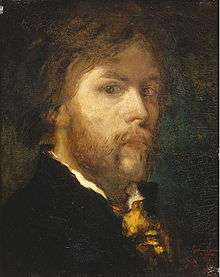 Self-portrait of Gustave Moreau, 1850 | |
| Born | 6 April 1826 Paris, France |
| Died | 18 April 1898 (aged 72) Paris, France |
| Nationality | French |
| Education | François-Édouard Picot |
| Known for | Painting |
| Movement | Symbolism |
Biography
Moreau was born in Paris, France, into an upper middle-class family. His father, Louis Jean Marie Moreau, was an architect for the city of Paris and his mother, née Adele Pauline Desmoutier, was a musician. Moreau lived a sheltered life growing up. Having visited Italy at age 15 he began his love for art. At age 18 he entered École des Beaux-Arts to study under the guidance of François-Édouard Picot and left in 1850.[1] He then began to study art under his new mentor Théodore Chassériau, whose work strongly influenced his own. Moreau participated in the Salon for the first time in 1852.
Moreau had a 25-year personal, possibly romantic relationship, with Adelaide-Alexandrine Dureux (b.Guise, 8 November 1835), a woman whom he drew several times.[2] His first painting was a Pietà which is now located in the cathedral at Angoulême. He showed A Scene from the Song of Songs and The Death of Darius in the Salon of 1853. In 1853, he contributed Athenians with the Minotaur and Moses Putting Off his Sandals within Sight of the Promised Land to the Great Exhibition.[3]
Oedipus and the Sphinx, one of his first Symbolist paintings, was exhibited at the Salon of 1864. Moreau quickly gained a reputation for eccentricity. One commentator said Moreau's work was "like a pastiche of Mantegna created by a German student who relaxes from his painting by reading Schopenhauer."[4] The painting currently resides in the permanent collection at the New York Metropolitan Museum of Art.[5]
On 28 March 1890, Alexandrine Dureux died. Her death affected Moreau greatly, and his work after this point contained a more melancholic edge. She was buried at the same cemetery where Moreau himself would later be buried.
Moreau became a professor at Paris' École des Beaux-Arts in October 1891. Among his many students were fauvist painters Henri Matisse and Georges Rouault. Jules Flandrin, Theodor Pallady and Léon Printemps also studied with Moreau. Pierre Marcel-Béronneau was "one of the most brilliant students" of Moreau.[6]
Moreau died of stomach cancer and was buried at the Cimetière de Montmartre in Paris in his parent's tomb.
He was made a Chevalier de la Légion d'honneur in 1875 and was promoted to an Officier de la Légion d'honneur in 1883.
Style of art
Influence of the Italian Renaissance
The death of Chasseriau in 1856 caused Moreau in his grief to stop painting and withdraw from public life. Concerned about his condition, Moreau's parents suggested he travel to Italy again. Living in Italy from 1857 to 1859 he found a new love for art.[1] He gained inspiration from the artists of the Italian Renaissance, such as Leonardo da Vinci and Michelangelo.[7] In 1864 Moreau won a medal at the Salon with his painting Oedipus and the Sphinx, the style of which revealed his close study of the work of Mantegna and Giovanni Bellini.[8] Its firm outlines and detailed modeling are typical of the works that brought him success with critics and the public for the remainder of the decade.[8] In the 1870s, disturbed by criticism that his work had become formulaic, he stopped exhibiting for a few years while he concentrated on renewing his art. In 1876 he completed Salome Dancing before Herod, which announced a more painterly style that would characterize his later works.[8]
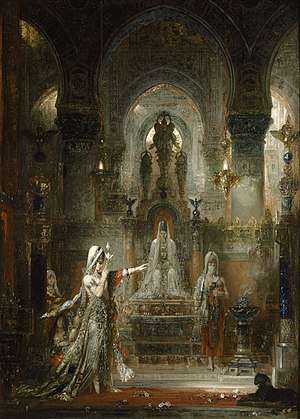
Exoticism
Gustave Moreau's education in classical drawing did not stop him from experimenting with different styles of art. By traveling to other countries such as Italy or Holland and reading publications Moreau was able to develop his unique form of art. The most important publications Moreau owned were The Grammar of Ornament by Owen Jones, Le costume historique by August Racinet, and Le Costume by Frederick Hottenroth.[9] All these influences led Moreau to draw not only humans, but animals and architectural monuments. Moreau started his career drawing classical art, but by incorporating exotic images he developed a mysterious and unique form of art.
Legacy
During his lifetime, Moreau produced more than 8,000 paintings, watercolors and drawings. His work influenced the next generation of Symbolists, particularly Odilon Redon and Jean Delville, a leading figure in Belgian Symbolism in the early part of the twentieth century.
Many of Moreau's works are on display in Paris' Musée national Gustave Moreau at 14 rue de la Rochefoucauld (9th arrondissement). The museum is in his former workshop, and began operation in 1903. André Breton famously used to "haunt" the museum and regarded Moreau as a precursor of Surrealism.
The Japanese artist Yoshitaka Amano, known for works such as Final Fantasy, Angel's Egg, and Vampire Hunter D, was inspired by Moreau's style. Amano said in an interview that when he was first experimenting with styles to try to find his own, he would try to mimic the works of Moreau.[10]
Gallery
- Gustave Moreau's works

 Jason and Medea (1865)
Jason and Medea (1865)
(Musée d'Orsay)
 Venus Rising from the Sea (1866) (Israel Museum)
Venus Rising from the Sea (1866) (Israel Museum) Europa and the Bull (1869)
Europa and the Bull (1869) La chimère (1876) (private collection)
La chimère (1876) (private collection)
 The Apparition (1876)
The Apparition (1876)
(Musée d'Orsay)
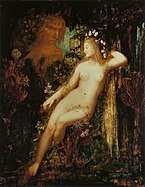 Galatée (1880)
Galatée (1880)
(Musée d'Orsay)_-_Google_Art_Project.jpg) The Sacred Elephant (Péri) (1885)
The Sacred Elephant (Péri) (1885)
(NMWA Tokyo).jpg) Eve by Gustave Moreau (1885)
Eve by Gustave Moreau (1885)
(private collection)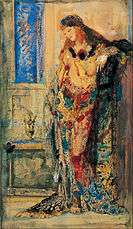 The Toilette (1885–90)
The Toilette (1885–90)
(Bridgestone Museum of Art)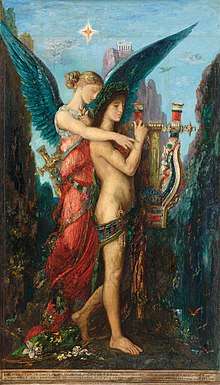
_-_Google_Art_Project.jpg)
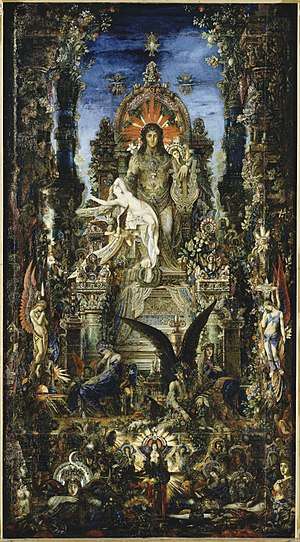
References
- Paladilhe, Jean (1972). Gustave Moreau: His Life and Work. Praeger Publishers. LCCN 71-151833.
- Kaplan, Julius (1974). Gustave Moreau. Little Brown & Company. pp. 7, 55. ISBN 0-8212-0628-1.
- "Artchive Gustave Moreau". www.artchive.com. Retrieved October 2014. Check date values in:
|access-date=(help) - Lucie-Smith, Edward. (1972) Symbolist Art. London: Thames & Hudson, p. 63. ISBN 0500201250
- Winkfield, Trevor (April 2012). "A Letter to Bryan Osburn from Trevor Winkfield". The Brooklyn Rail.
- Guérin, Jean (1957). Des hommes et des activities: autour d'un demi-siecle. p. 72.
Marcel Béronneau travailla d'abord à l'Ecole des beaux-arts de Bx en même temps que Fernand Sabatté, puis devint un des élèves les plus brillants de l'atelier de Gustave Moreau à l'Ecole des beaux-arts de Paris.
- Moreau's interest in Leonardo was conditioned by the fact that French historians claimed Leonardo died in France in the hands of King Francois I, according to Valentin, Robert Francois (1841). Les Peintres celebres. Tours. p. 50.
- Julius Kaplan. "Moreau, Gustave". Grove Art Online. Oxford Art Online. Oxford University Press.
- Owen Jones, Grammaire de l'ornement (London, 1865; first ed., London 1856), pl. 28, no.22 (MGM, Inv. 14806); Auguste Racinet, Le Costume hisetorique, 6 vols. (Paris, 1888) (MGM Inv. 10387); Frederick Hottenroth, Le Costume les armes, ustensiles, outils des peuples anciens et modernes (Paris, [1885-99]), p. 17, fig. 7 (MGM Inv. 10391)
- https://www.destructoid.com/this-mini-documentary-makes-me-love-yoshitaka-amano-even-more-469313.phtml
External links
| Wikimedia Commons has media related to Gustave Moreau. |
| Wikiquote has quotations related to: Gustave Moreau |
| Wikisource has the text of the 1911 Encyclopædia Britannica article Moreau, Gustave. |